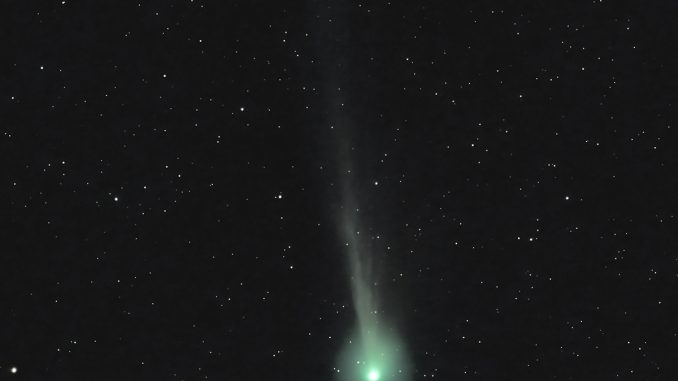
A host of exciting celestial events for skywatchers starts with a comet at the beginning of March, the change of the constellation guard as the seasons shift and ending with a total solar eclipse. Steve Bellavia, research, education and outreach coordinator at Custer Institute and Observatory in Southold, shared what not to miss in March and April.
Comet 12P Pons-Brooks, the 12th periodic comet discovered since 1P Halley, is best seen in early March before “the moon comes back,” Mr. Bellavia suggested. A periodic comet is one with an orbital period of less than 200 years. Pons-Brooks is viewable every 71 years, similar to Halley’s comet’s average of every 76 years. It was discovered in 1812 by Jean-Louis Pons and then confirmed by William Robert Brooks in 1883, hence the name Pons-Brooks, Mr. Bellavia said. The next new moon is this Saturday, March 9, so peak comet viewing is this week until about mid-month.
“It will be close to the Andromeda galaxy, making this a nice part of the sky to view with binoculars or a small telescope,” Mr. Bellavia said of Comet 12P Pons-Brooks. He suggested it might be visible to the naked eye during the upcoming total solar eclipse since it will be just 24 degrees east of the sun and approaching its perihelion — when its orbit is closest to the sun.
The clocks spring ahead this weekend on Sunday, March 10. The season officially changes March 19, the day of the spring equinox, where there are equal parts day and nighttime. Mr. Bellavia noted these are the last licks to see the winter hunter constellation Orion, which will soon set for the season and be replaced by the summer hunter, Hercules.
“Orion is not just stars,” Mr. Bellavia noted. “It also contains a wealth of nebulae and star clusters. The nebula types cover the full range, from dark, to reflection to emission,” he added.
Mr. Bellavia mentioned a few notable stars throughout the constellation. Orion’s shoulders are the red supergiant Betelgeuse and Bellatrix. His foot and knee are the blue supergiant Rigel and Saiph, respectively. “His belt, perhaps one of the most notable asterisms,” Mr. Bellavia said, “comprise Alnitak, Alnilam and Mintaka — which is a nice double star.”

The main event for March and April, however, has to be the total solar eclipse on Monday, April 8. The moon will align with the sun, creating a shadow across the Earth. Here in New York, we can expect to see a partial solar eclipse with the moon covering roughly 90 percent of the sun. The peak of the eclipse is set for 3:15 p.m. This celestial event will not occur again in our area for another 20 years, in 2044.
The Custer Institute and Observatory is giving skywatchers the chance to witness the solar eclipse on April 8 from 2:30 to 4 p.m. through their state-of-the-art telescopes and using certified safe solar eclipse viewing glasses. Bring a blanket or chair to view the eclipse from the observatory lawn with certified safe solar viewing glasses provided at program check-in. The event costs $10 for adults, $8 for children under 16 and $5 for observatory members. There is limited space and registration is strongly encouraged.

